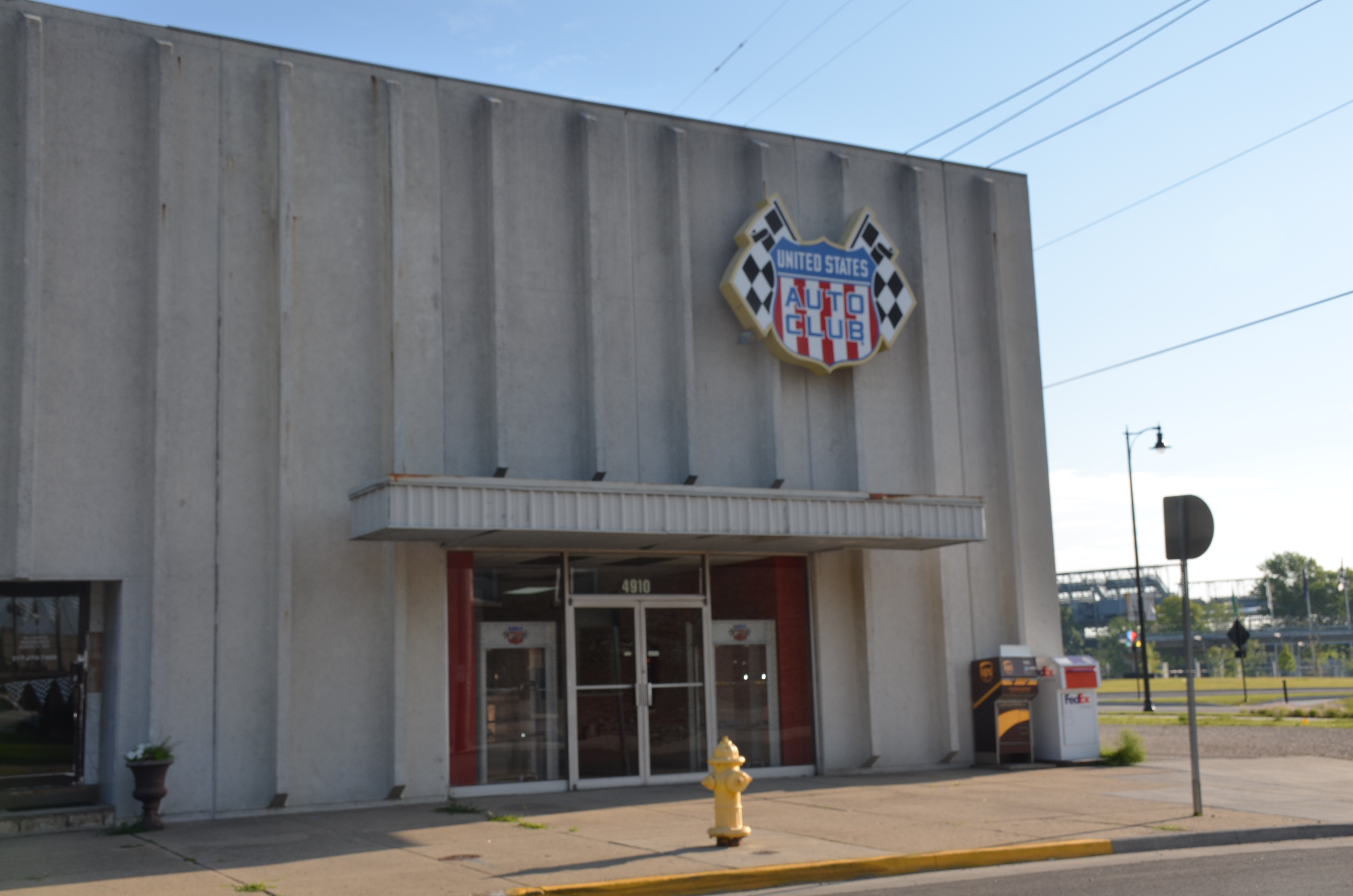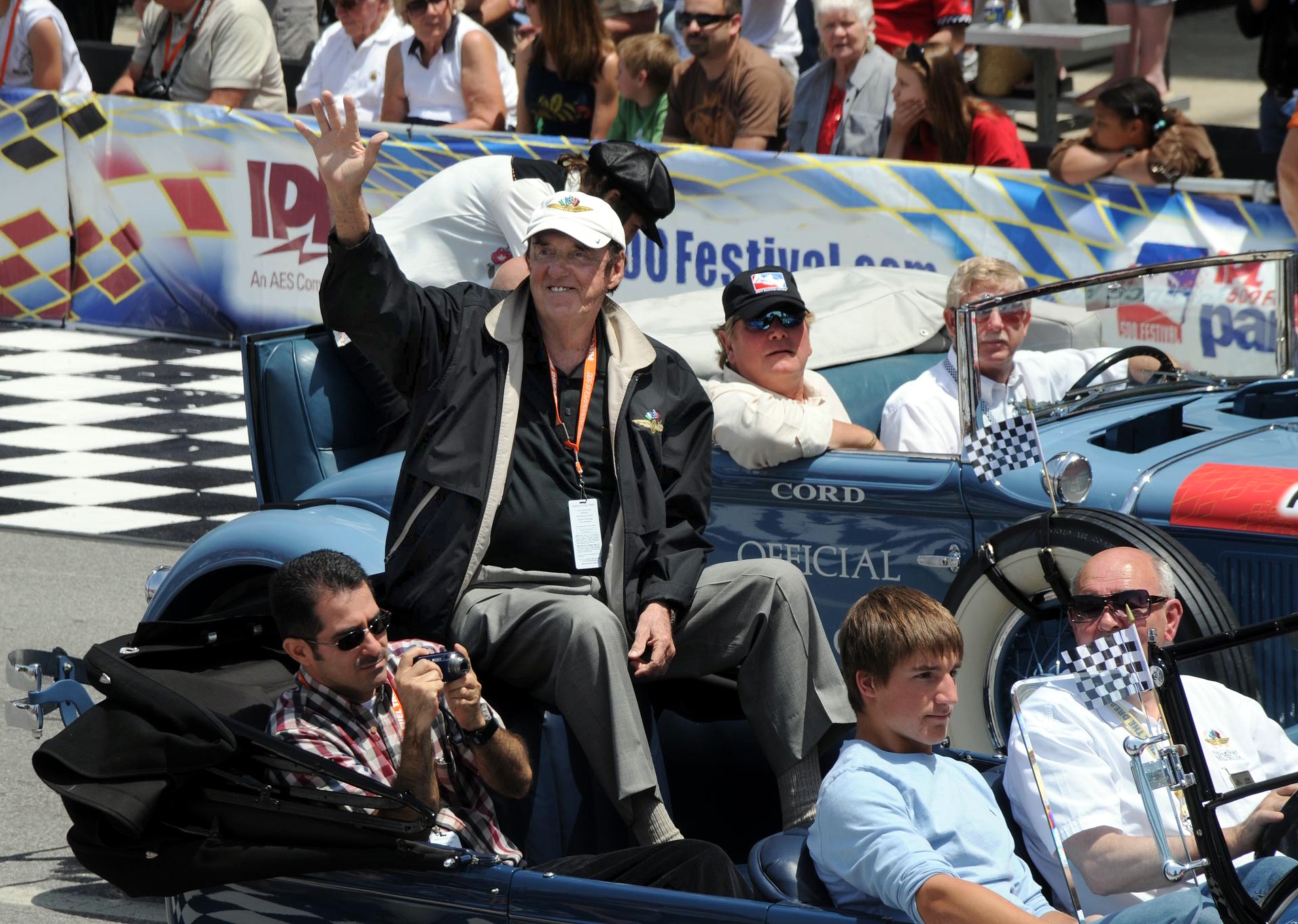|
1974 Indianapolis 500
The 58th 500 Mile International Sweepstakes was held at the Indianapolis Motor Speedway in Speedway, Indiana on Sunday, May 26, 1974. Johnny Rutherford, in his eleventh attempt, won the race from the 25th starting position, the farthest back since Louis Meyer in 1936. It was the first of his three Indy victories, and started a three-year stretch where he finished 1st-2nd-1st. The race was run relatively clean, with no major crashes or injuries, a sharp contrast from the tragic 1973 event. In order to increase safety, significant improvements were made to the track and cars. Wings were reduced in size, fuel tank capacity was reduced, and pop-off valves were added to the turbocharger plenums in order to reduce horsepower and curtail speeds. For the first time in Indy history, the race was scheduled for the Sunday of Memorial Day weekend. This ended the " never on a Sunday" policy previously held from 1911 to 1973. At the time, it was also the earliest calendar date (May 26) that t ... [...More Info...] [...Related Items...] OR: [Wikipedia] [Google] [Baidu] |
United States Auto Club
The United States Auto Club (USAC) is one of the sanctioning bodies of auto racing in the United States. From 1956 to 1979, USAC sanctioned the List of USAC Championship Car seasons, United States National Championship, and from 1956 to 1997 the organization sanctioned the Indianapolis 500. Today, USAC serves as the sport governing body, sanctioning body for a number of racing series, including the Silver Crown Series, National Sprint Cars, National Midgets, Speed2 Midget Series, .25 Midget Series, Stadium Super Trucks, and Pirelli World Challenge. Seven-time USAC champion Levi Jones (racing driver), Levi Jones is USAC's Competition Director. History When the American Automobile Association (AAA) withdrew from auto racing after the 1955 season, citing the 1955 Le Mans disaster, Le Mans disaster and the death of Bill Vukovich at 1955 Indianapolis 500, Indianapolis as contributing factors, both the Sports Car Club of America, SCCA and NASCAR were mentioned as its potential success ... [...More Info...] [...Related Items...] OR: [Wikipedia] [Google] [Baidu] |
Speedway, Indiana
Speedway is a town in Wayne Township, Marion County, Indiana, United States. The population was 11,812 at the 2010 U.S. Census. Speedway, which is an enclave of Indianapolis, is the home of the Indianapolis Motor Speedway. History Speedway was laid out in 1912 as a residential suburb. It took its name from the Indianapolis Motor Speedway. It is an early example of a residential community planned for the industrial plants located nearby. Carl G. Fisher, James A. Allison, Frank Wheeler, and Arthur Newby, founders of the Indianapolis Motor Speedway, planned the suburb of Speedway west of the track. Fisher and Allison owned plants that needed workers, the Prest-O-Lite factory and Allison Engine Company. The investors' goal was to create a city without horses, where residents would drive automobiles, as well as participate in creating mechanical parts for new modes of transportation. The Speedway Historic District was listed on the National Register of Historic Places in 2005. Geo ... [...More Info...] [...Related Items...] OR: [Wikipedia] [Google] [Baidu] |
1973 Oil Crisis
The 1973 oil crisis or first oil crisis began in October 1973 when the members of the Organization of Arab Petroleum Exporting Countries (OAPEC), led by Saudi Arabia, proclaimed an oil embargo. The embargo was targeted at nations that had supported Israel during the Yom Kippur War. The initial nations targeted were Canada, Japan, the Netherlands, the United Kingdom and the United States, though the embargo also later extended to Portugal, Rhodesia and South Africa. By the end of the embargo in March 1974, the price of oil had risen nearly 300%, from US to nearly globally; US prices were significantly higher. The embargo caused an oil crisis, or "shock", with many short- and long-term effects on global politics and the global economy. It was later called the "first oil shock", followed by the 1979 oil crisis, termed the "second oil shock". Background Arab-Israeli conflict Ever since the recreation of the State of Israel in 1948 there has been Arab–Israeli conflict in the ... [...More Info...] [...Related Items...] OR: [Wikipedia] [Google] [Baidu] |
2022 Indianapolis 500
The 2022 Indianapolis 500 (branded as the 106th Running of the Indianapolis 500 presented by Gainbridge for sponsorship reasons) was a 500-mile (804.7 km, 200 lap) race in the 2022 IndyCar Series, held on Sunday, May 29, 2022, at the Indianapolis Motor Speedway in Speedway, Indiana. The month of May activities formally began on May 14 with the GMR Grand Prix on the combined road course. Practice on the oval opened on May 17, and time trials took place on May 21–22. Carb Day, the traditional final day of practice, along with the Pit Stop Challenge, took place on May 27. Six-time IndyCar champion, and 2008 Indianapolis 500 winner Scott Dixon won the pole position, his fifth career Indy 500 pole. It was also Chip Ganassi Racing's seventh Indy pole. Dixon's qualifying speed of was the fastest Indy 500 pole speed of all time, and the second-fastest Indy 500 qualifying attempt in history. Dixon moved into second on the all-time list for poles at Indy, behind only Rick Mears ... [...More Info...] [...Related Items...] OR: [Wikipedia] [Google] [Baidu] |
Chet Miller
Chester Miller (July 19, 1902 – May 15, 1953) was an American racecar driver. He was killed in a crash in the south turn of the Indianapolis Motor Speedway during practice for the 1953 Indianapolis 500. Yates, Brock W. "The Indianapolis 500: The Story of the Motor Speedway." Harper and Brothers: New York. 1956. Page 67. During his long Indy career, Miller earned the nickname "Dean of the Speedway." He died at age 50 while driving a Novi-engined Special. He is interred at Crown Hill Cemetery in Indianapolis. Indianapolis 500 results *Although Miller posted the fastest qualifying time for the 1952 Indianapolis 500, he started on the outside of the ninth row. No other fastest qualifier has started this far back in the field. *Miller drove 2,061 laps, or at Indianapolis without leading a lap, an all-time record. Complete Formula One World Championship results (key) (Races in ''italics'' indicate fastest lap) World Championship career summary Although run to a complet ... [...More Info...] [...Related Items...] OR: [Wikipedia] [Google] [Baidu] |
Cliff Bergere
Cliff Bergere (December 6, 1896 Toledo, Ohio – June 18, 1980 Dade City, Florida) was an American stuntman and racecar driver. Bergere did stunt driving for movies, including the 1923 film ''The Eagle's Talons'', before embarking on a racing career. From 1927 to 1947, he started the Indianapolis 500 sixteen times, missing only the 1930 race. He started the race from the front row three times and won the pole in 1946. At age 49, he was the oldest pole winner ever. He finished third in 1932 and 1939 and completed the 1941 race without making a pit stop, finishing fifth. Bergere had the distinction of the most starts in Indy 500 history at the time of his career (16), a record he held until 1974 Major events in 1974 include the aftermath of the 1973 oil crisis and the resignation of United States President Richard Nixon following the Watergate scandal. In the Middle East, the aftermath of the 1973 Yom Kippur War determined politics; f .... Indianapolis 500 results R ... [...More Info...] [...Related Items...] OR: [Wikipedia] [Google] [Baidu] |
Uniform Monday Holiday Act
The Uniform Monday Holiday Act () is an Act of Congress that moved permanently to a Monday three Federal holidays in the United States—Washington's Birthday (colloquially Presidents’ Day), Memorial Day, and Labor Day—and that made Columbus Day a federal holiday, also permanently on a Monday. This created long weekends with three days off ending with the holidays, such as Memorial Day Weekend and Labor Day Weekend. Veterans Day was moved from November 11 to the fourth Monday in October but in 1978 it was returned to November 11, the actual date of the end of World War I (see Armistice of 11 November 1918) and celebrated in several European countries as Armistice Day. The Act was signed into law on June 1, 1968, and took effect on January 1, 1971.''An Act to provide for uniform annual observances of certain legal public holidays on Mondays, and for other purposes'', . Background The Act was designed to increase the number of three-day weekends for federal employees, a f ... [...More Info...] [...Related Items...] OR: [Wikipedia] [Google] [Baidu] |
Indianapolis 500 Traditions
Due to the longevity of the Indianapolis 500, numerous traditions surrounding the race have developed over the years. Traditions include procedures for the running of the race, scheduling, and pre-race and post-race festivities. For many fans, these traditions are an important aspect of the race, and they have often reacted quite negatively when the traditions are changed or broken. As part of the Memorial Day holiday weekend, the pre-race ceremonies of the Indianapolis 500 feature several patriotic songs. Like most other sporting events, the national anthem is performed before the race by a notable vocalist. The most noteworthy and most popular traditions are the annual singing of the chorus of "Back Home Again in Indiana," and the victory lane bottle of milk. Month of May The two to three weeks of practice and qualifying leading up to the Indianapolis 500 is known in racing circles simply as "the month of May t Indianapolis. In early years, the track traditionally opened for ... [...More Info...] [...Related Items...] OR: [Wikipedia] [Google] [Baidu] |
Memorial Day
Memorial Day (originally known as Decoration Day) is a federal holiday in the United States for mourning the U.S. military personnel who have fought and died while serving in the United States armed forces. It is observed on the last Monday of May; from 1868 to 1970 it was observed on May 30. Many people visit cemeteries and memorials on Memorial Day to honor and mourn those who fought and died while serving in the U.S. military. Many volunteers place American flags on the graves of military personnel in national cemeteries. Memorial Day is also considered the unofficial beginning of summer in the United States. The first national observance of Memorial Day occurred on May 30, 1868. Then known as Decoration Day, the holiday was proclaimed by Commander in Chief John A. Logan of the Grand Army of the Republic to honor the Union soldiers who had died in the Civil War. This national observance was preceded by many local ones between the end of the Civil War and Logan's declara ... [...More Info...] [...Related Items...] OR: [Wikipedia] [Google] [Baidu] |
Horsepower
Horsepower (hp) is a unit of measurement of power, or the rate at which work is done, usually in reference to the output of engines or motors. There are many different standards and types of horsepower. Two common definitions used today are the mechanical horsepower (or imperial horsepower), which is about 745.7 watts, and the metric horsepower, which is approximately 735.5 watts. The term was adopted in the late 18th century by Scottish engineer James Watt to compare the output of steam engines with the power of draft horses. It was later expanded to include the output power of other types of piston engines, as well as turbines, electric motors and other machinery. The definition of the unit varied among geographical regions. Most countries now use the SI unit watt for measurement of power. With the implementation of the EU Directive 80/181/EEC on 1 January 2010, the use of horsepower in the EU is permitted only as a supplementary unit. History The development of the stea ... [...More Info...] [...Related Items...] OR: [Wikipedia] [Google] [Baidu] |
Turbocharger
In an internal combustion engine, a turbocharger (often called a turbo) is a forced induction device that is powered by the flow of exhaust gases. It uses this energy to compress the intake gas, forcing more air into the engine in order to produce more power for a given displacement. The current categorisation is that a turbocharger is powered by the kinetic energy of the exhaust gasses, whereas a supercharger is mechanically powered (usually by a belt from the engine's crankshaft). However, up until the mid-20th century, a turbocharger was called a "turbosupercharger" and was considered a type of supercharger. History Prior to the invention of the turbocharger, |
Blowoff Valve
A blowoff valve (also called dump valve or compressor bypass valve) is a pressure release system present in most petrol turbocharger, turbocharged engines. Blowoff valves are used to reduce pressure in the intake system as the throttle is closed, thus preventing Compressor stall, compressor surge. Design A key function of blowoff valves is to prevent Compressor stall, compressor surge, a phenomenon that would otherwise occur as the throttle is closed in a turbocharged engine. If the turbocharger's compressor wheel is spinning at high speed when the throttle is suddenly closed (such as during a gear change), the flow reduces beyond the surge line of the compressor. At this point the change in pressure across the compressor reduces, leading to a collapse in flow and possibly even flow reversal and a collapse in plenum pressure. As the compressor is still spinning at high speed, once the flow has reduced sufficiently, the change in pressure across the compressor begins to rise an ... [...More Info...] [...Related Items...] OR: [Wikipedia] [Google] [Baidu] |



.jpg)





